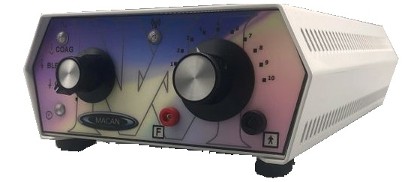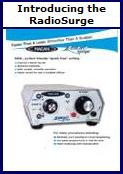 |
Lion's Dental Supply & Equipment
|
|
|
|
|
 |
|
|
|
|
Radiosurge Electrosurge MC-6A By Macan |
 |
Macan Electrosurge Radiosurge MC-6A
The Macan Radiosurge MC-6A is a high precision dental electrosurgery unit especially effective for delicate and intricate tissue management in prosthodontics, but versatile and affordable. The Radiosurge MC-6A offers cicatrix free CUT mode, incision and excision with pronounced concurrent homeostasis in BLEND mode, and pin-point accurate coagulation in COAG mode. This unit has been UL tested to full operating room standards; the isolated output instrument is safe for concurrent use with monitoring equipment such as EKG monitors, apnea monitors, and pulse oximeters. The isolated output allows safe and effective bipolar coagulation, which is effective in wet or bloody fields even on exposed bone as well as soft tissue and small vessels. Low voltage output for virtually "spark-free" incisions that help to assure patient comfort under all anesthesia conditions and significantly reduces any risk of tissue damage or recession. The unit comes with our unique "Flexi-plate" which resides on the chair eliminating the need for attention with each case. Simple attachment allows ready portability between rooms and supple design insures patient comfort. The unit works through normal street clothing and comes with a set of 6 "Ultraflex" dental electrodes, The Radiosurge MC-6A has a 3 year warranty . IEC 60601-1-2 EMC compliance make this instrument as friendly as possible around other equipment.

Macan MC-6A Radiosurge Owners Manual
reg $ 2,699 Sale $ 2,211
|
|
Cut Mode - This fully rectified, filtered waveform is the safest and most predictable waveform for oral electrosurgery procedures. When utilizing the cut mode in healthy tissue, there will be no shrinkage. It produces a continuous flow of RF energy that provides a micro-smooth cut with minimal hemostatsis. Indications would include cosmetic elongation of clinical crowns, anterior gingival troughing before crown & bridge impressions, biopsies, frenectomies, reflection of full thickness flaps and any procedures that closely proximate bone or dental implants.
Cut + Coag Mode - Clinically, this fully rectified waveform results in a blend of 50% cutting and 50% coagulation. It would be the waveform of choice for posterior gingival troughing before crown & bridge gaining access to subgingival caries, removing opercula, removing opercula, removing pericoronal tissue, pulpotomies, gingivectomies and gingivoplasty procedures.
Coag Mode - This partially rectified waveform of intermittent RF energy flow is highly effective in producing hemostasis in gingival an mucosal tissues and sealing off bleeders up to two millimeters in diameter without ligation. Indications include soft tissue coagulation after surgical intervention or bleeding = a pulpotomy. This waveform may also be used for sterilization of endodontic canals, bleaching discolorized teeth and desensitzation of cervical tooth margins.
Fulguration Mode - This mode produces a spark that travels through the air gap between the electrode tip and the surface of the tissue. It is the only monopolar electrosurgical waveform that can coagulate bleeding coming from the bone. It is also excellent to diagnose and coagulate possible pin-point exposures.
Construction
Printed circuit boards. Filtered, full and partial wave solid state rectification with vacum tube oscillator. Aircraft-strength aluminum chassis and cover.
ACCESSORIES
The Radio Surge comes complete with autoclaveable handpiece and cord, six Ultra Flex Bendable Electrodes (UF-L22, UF-C51, UF-L34, UF-L35, UF-F1, UF-SN62), thermoplastic coated ground plate, ground cord and a 14 page operating manual. Special length cables are available for custom installations.
|
|
|
|
|
RADIOSURGE MC6A ELECTROSURGERY UNIT TECHNICAL SPECIFICATIONS
|
| IEC CLASSIFICATION class 2 medical, high frequency surgical, non-ionizing radiation device |
| CONFIGURATION monopolar, isolated output, type BF ports |
| OPERATING MODES |
CUT |
CW .5% ripple, max 50watts into 100ohms +10%-5%, crest factor 1.4 |
| OUTPUT VOLTAGE 500V p-p (.5kVp p-p), open load, SURGE mode |
| SOURCE IMPEDANCE 500ohms, nominal |
| OPERATING FREQUENCY 3.0mHz +/-5%, nominal |
| POWER CONTROL manual analog, continuously variable |
| OPERATIONAL DUTY CYCLE 10 seconds ON, 20 seconds OFF (not electronically enforced) |
| TEMPERATURE RANGE -20C to +85C storage, OC to +40C operating, <80% RH non condensing |
| COOLING convection |
| SPALSH RATING IPO |
| ACTUATION single foot pedal (isolated low voltage circuit, IP20 splash resistant rust proof plastic pedal) |
| DISPERSIVE MONITOR N/A |
| ACTIVE INDICATION LED light, tone (defeatible) |
| POWER REQUIRMENTS |
120V 60Hz, +/-10%, 240watts maximum consumption |
| |
230V 50HZ, +/-10%, 240VA maximum consumption |
| |
NOTE: field selection of operating voltage requires a skilled technician |
| SIZE AND WEIGHT |
11.5"w, 6.5"h, 2.75"d, not including controls and jacks 5.5pounds (9 pound shipping) |
| |
21,6cm w; 8.89cm h; 14.6cm d; not including controls and jacks 2.5kg (4.1kg shipping) |
| WARRANTY 3 years (exclusive of accessories) |
|
Comparison of Radiofrequency and Electrocautery With Conventional Scalpel Incisions
Purpose
The disadvantages of conventional scalpels, including insufficient control of bleeding, prompted us to search for new alternative methods such as electrosurgery and radiosurgery. In this study, the conventional scalpel was compared with radiosurgery and electrosurgery for wound healing with assessment of lateral heat production, inflammation, and instrument performance.
Materials and Methods
Incisions were made in the palatal mucosa of 42 Wistar rats using a scalpel, electrocautery instrument, or radiofrequency instrument. Postoperative hemostasis, tissue coagulation, and tissue sticking were measured, and pain evaluation through weight loss was recorded. Gingival biopsy specimens from the surgical area were obtained at the time of surgery and 2, 4, 7, and 14 days postoperatively and were evaluated immunohistochemically for inducible nitric oxide synthase and heat shock protein 70. Kruskal-Wallis, 1-way analysis of variance, and Mann-Whitney U tests were used for statistical evaluation.
Results
The rats in the electrosurgery and radiosurgery groups had aggressively greater weight loss when compared with the scalpel group in the first 7 days. Hemostasis was better in the electrocautery group, tissue coagulation was greater in the radiofrequency group (P < .001), and tissue sticking was lesser in the scalpel group (P < .001) compared with the other groups. Inducible nitric oxide synthase expression and heat shock protein 70 expression were similar in all 3 groups.
Conclusions
Electrosurgery performed better regarding hemostasis, whereas a scalpel was superior in terms of tissue sticking and tissue coagulation. Radiosurgery was superior regarding hemostasis when compared with a conventional scalpel, but it was not as successful as electrosurgery. |
Copyright © 2013 Web Design by Web.com Group, Inc. |
|
|
 |
 |
|
 |
|

